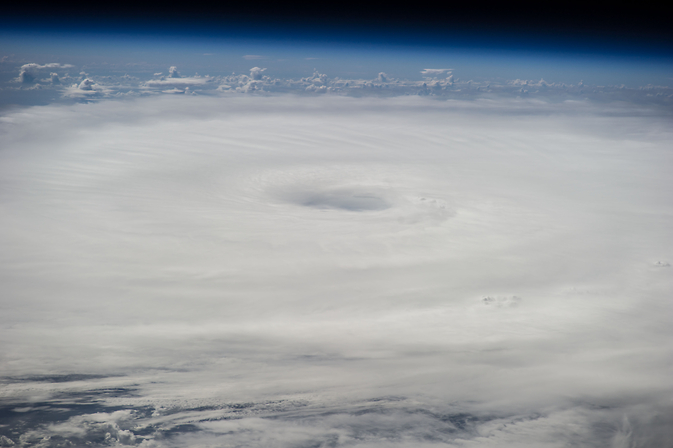NASA Sees Hurricane Edouard Far From U.S., But Creating Rough Surf

This photograph of Hurricane Edouard was taken from the International Space Station on Sept. 17, 2014. Image Credit: NASA JSC/ISS
On Sept. 17, the National Hurricane Center noted “Swells from Edouard will affect portions of the east coast of the United States north of Florida beginning today. These swells will likely cause life-threatening rip current conditions along most of the United States east coast for the next couple of days.”
When NASA's Aqua satellite passed over Hurricane Edouard on Sept. 16 the MODIS instrument captured a visible image of the storm that it still maintained its eye. Bands of powerful thunderstorms were spinning into the center from the north and south.
At 11 a.m. EDT on Sept. 17, Edouard's maximum sustained winds were near 90 mph (150 kph) and weakening is forecast. The eye of Hurricane Edouard was located near latitude 36.4 north and longitude 53.3 west. Edouard is moving toward the northeast near 24 mph (39 kph) and turn east on Sept. 18. The latest minimum central pressure reported by a NOAA Hurricane Hunter aircraft is 958 millibars.
The National Hurricane Center expects rapid weakening on Sept. 18 with Edouard dropping in intensity to a tropical storm.
Rob Gutro
NASA's Goddard Space Flight Center
Media Contact
More Information:
http://www.nasa.gov/content/goddard/td6-atlantic-ocean/All latest news from the category: Earth Sciences
Earth Sciences (also referred to as Geosciences), which deals with basic issues surrounding our planet, plays a vital role in the area of energy and raw materials supply.
Earth Sciences comprises subjects such as geology, geography, geological informatics, paleontology, mineralogy, petrography, crystallography, geophysics, geodesy, glaciology, cartography, photogrammetry, meteorology and seismology, early-warning systems, earthquake research and polar research.
Newest articles

Properties of new materials for microchips
… can now be measured well. Reseachers of Delft University of Technology demonstrated measuring performance properties of ultrathin silicon membranes. Making ever smaller and more powerful chips requires new ultrathin…

Floating solar’s potential
… to support sustainable development by addressing climate, water, and energy goals holistically. A new study published this week in Nature Energy raises the potential for floating solar photovoltaics (FPV)…

Skyrmions move at record speeds
… a step towards the computing of the future. An international research team led by scientists from the CNRS1 has discovered that the magnetic nanobubbles2 known as skyrmions can be…




















